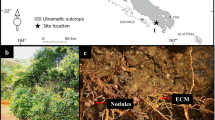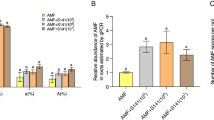Abstract
Two strains of Bradyrhizobium sp., Aust 13C and Aust 11C, were dually or singly inoculated with an ectomycorrhizal fungus, Pisolithus albus to assess the interactions between ectomycorrhizal symbiosis and the nodulation process in glasshouse conditions. Sequencing of strains Aust 13C and Aust 11C confirmed their previous placement in the genus Bradyrhizobium. After 4 months’ culture, the ectomycorrhizal symbiosis promoted plant growth and the nodulation process of both Bradyrhizobium strains, singly or dually inoculated. PCR/RFLP analysis of the nodules randomly collected in each treatment with Aust 13C and/or Aust 11C: (1) showed that all the nodules exhibited the same patterns as those of the Bradyrhizobium strains, and (2) did not detect contaminant rhizobia. When both Bradyrhizobium isolates were inoculated together, but without P. albus IR100, Aust 11C was recorded in 13% of the treated nodules compared to 87% for Aust 13C, whereas Aust 11C and Aust 13C were represented in 20 and 80% of the treated nodules, respectively, in the ectomycorrhizal treatment. Therefore Aust 13C had a high competitive ability and a great persistence in soil. The presence of the fungus did not significantly influence the frequencies of each Bradyrhizobium sp. root nodules. Although the mechanisms remain unknown, these results showed that the ectomycorrhizal and biological nitrogen-fixing symbioses were very dependent on each other. From a practical point of view, the role of ectomycorrhizal symbiosis is of great importance to N2 fixation and, consequently, these kinds of symbiosis must be associated in any controlled inoculation.



Similar content being viewed by others
References
André S, Neyra M, Duponnois R (2003) Arbuscular mycorrhizal symbiosis changes the colonization pattern of Acacia tortilis ssp. raddiana rhizosphere by two strains of Rhizobia. Microb Ecol 45:137–144
Azcon R, El-Atrach F, Barea JM (1988) Influence of mycorrhiza vs. soluble phosphate on growth and N2 fixation (15N) in alfalfa under different levels of water potential. Biol Fertil Soils 7:28–31
Blilou I, Ocampo JA, Gracia-Garrido JM (1999) Resistance of pea roots to endomycorrhizal fungus or Rhizobium correlates with enhanced levels of endogenous salicylic acid. J Exp Bot 50:1663–1668
Bolan NS (1991) A critical review on the role of mycorrhizal in the uptake of phosphorus by plants. Plant Soil 134:189–207
Caravaca F, Garcia C, Hernandez MT, Roldan A (2002) Aggregate stability changes after organic amendment and mycorrhizal inoculation in the afforestation of a semiarid site with Pinus halepensis. Appl Soil Ecol 19:199–208
Cornet F, Diem HG (1982) Etude comparative de l’efficacité des souches de Rhizobium d’Acacia isolées de sols du Sénégal et effet de la double symbiose Rhizobium–Glomus mosseae sur la croissance de Acacia holosericea et A. raddiana. Bois For Trop 198:3–15
Ducousso M (1990) Importance des symbioses racinaires pour l’utilisation des acacias d’Afrique de l’Ouest. Doctoral thesis. Université Montpellier
Duponnois R, Garbaye J (1991) Techniques for controlled synthesis of the Douglas fir—Laccaria laccata ectomycorrhizal symbiosis. Ann Sci For 48:239–251
Duponnois R, Founoune H, Bâ AM, Plenchette C, El Jaafari S, Neyra M, Ducousso M (2000) Ectomycorrhization of Acacia holosericea A. Cunn ex G. Don by Pisolithus spp. In Senegal: effect on plant growth and on the root-knot nematode Meloidogyne javanica. Ann For Sci 57:345–350
Duponnois R, Founoune H, Lesueur D (2002) Influence of controlled dual ectomycorrhizal and rhizobial symbiosis on the growth of Acacia mangium provenances, the indigenous symbiotic microflora and the structure of plant parasitic nematode communities. Geoderma 109:85–102
Duponnois R, Plenchette C (2003) A mycorrhiza helper bacterium enhances ectomycorrhizal and endomycorrhizal symbiosis of Australian Acacia species. Mycorrhiza 13:85–91
Felsenstein J (1993) PHYLIP (Phylogeny Inference Package) version 3.5c. Distributed by the author. Department of Genetics, University of Washington, Seattle, Wash.
Founoune H, Duponnois R, Bâ AM (2002a) Ectomycorrhization of Acacia mangium, Willd. and Acacia holosericea, A. Cunn. Ex G. Don in Senegal. Impact on plant growth, populations of indigenous symbiotic microorganisms and plant parasitic nematodes. J Arid Environ 50:325–332
Founoune H, Duponnois R, Bâ AM, Sall S, Branget I, Lorquin J, Neyra M, Chotte JL (2002b) Mycorrhiza helper bacteria stimulate ectomycorrhizal symbiosis of Acacia holosericea with Pisolithus alba. New Phytol 153:81–89
Founoune H, Duponnois R, Meyer JM, Thioulouse J, Masse D, Chotte JL, Neyra M (2002c). Interactions between ectomycorrhizal symbiosis and fluorescent pseudomonads on Acacia holosericea: isolation of mycorrhiza helper bacteria (MHB) from a soudano-Sahelian soil. FEMS Microbiol Ecol 41:37–46
Frémont M, Prin Y, Chauvière M, Diem HG, Pwee KH, Tan TK (1999) A comparison of Bradyrhizobium strains using molecular, cultural and field studies. Plant Sci 141:81–91
Frey P, Frey-Klett P, Garbaye J, Berge O, Heulin T (1997) Metabolic and genotypic fingerprinting of fluorescent pseudomonads associated with the Douglas fir Laccaria bicolor mycorrhizosphere. Appl Environ Microbiol 63:1852–1860
Galiana A, Chaumont J, Diem HG, Dommergues YR (1990) Nitrogen-fixing potential of Acacia mangium and Acacia auriculiformis seedlings inoculated with Bradyrhizobium and Rhizobium spp. Biol Fertil Soils 9:261–267
Galiana A, Prin Y, Mallet B, Gnahoua GM, Poitel M, Diem HG (1994) Inoculation of A. mangium with alginate beads containing selected Bradyrhizobium strains under field conditions: long-term effect on plant growth and persistence of the introduced strains in soil. Appl Environ Microbiol 60:3974–3980
Galiana A, Balle P, N’Guessan Kanga A, Domenach AM (2002) Nitrogen fixation estimated by the 15N natural abundance method in Acacia mangium Willd. Inoculated with Bradyrhizobium sp. and grown in silvicultural conditions. Soil Biol Biochem 34:251–262
Garbaye J (1991) Biological interactions in the mycorrhizosphere. Experientia 47:370–375
Garbaye J, Bowen GD (1989) Ectomycorrhizal infection of Pinus radiata by Rhizopogon luteolus is stimulated by microorganisms naturally present in the mantle of ectomycorrhizas. New Phytol 112:383–388
Katznelson H, Rouatt JW, Peterson EA (1962) The rhizosphere effect of mycorrhizal and non-mycorrhizal roots of yellow birch seedlings. Can J Bot 40:377–382
Koponen P, Nygren P, Domenach AM, Le Roux C, Saur E, Roggy JC (2003) Nodulation and Dinitrogen Fixation of Legume Trees in a Tropical Freshwater swamp Forest in French Guiana. J Trop Ecol 19:655–666
Le Tacon F, Garbaye J, Bâ AM, Beddiard A, Diagne O, Diem HG (1989) L’importance des symbioses racinaires pour les arbres forestiers en zone tropicale sèche et en zone tropicale humide. In: Trees and Development, Proceedings of the IFS Seminar, 20–25 February 1989, Nairobi. pp 33–45
Linderman RG (1988) Mycorrhizal interactions with the rhizosphere microflora: the mycorrhizosphere effect. Phytopathology 78:366–371
Martin F, Diez J, Dell B, Delaruelle C (2002) Phylogeography of the ectomycorrhizal Pisolithus species as inferred from the ribosomal DNA ITS sequences. New Phytol 153:345–358
Marshner P, Crowley DE, Lieberei R (2001) Arbuscular mycorrhizal infection changes the bacterial 16 S rDNA community composition in the rhizosphere of maize. Mycorrhiza 11:297–202
Marx DH (1969) The influence of ectotropic mycorrhizal fungi on the resistance of pine roots to pathogenic infections. I. Antagonism of mycorrhizal fungi to root pathogenic fungi and soil bacteria. Phytopathology 59:153–163
Muller J, Boller T, Wiemken A (1995) Trehalose and trehalase in plants: recent developments. Plant Sci 112:1–9
Normand P, Orso S, Cournoyer B, Jeannin P, Chapelon C, Dawson J, Evtushenko L, Misra AK (1996) Molecular Phylogeny of the Genus Frankia and Related Genera and Emendation of the Family Frankiaeceae. Int J Syst Bacteriol 46:1–9
Parniske M (2000) Intracellular accommodation of microbes by plant: a common developmental program for symbiosis and disease? Curr Opin Plant Biol 3:320–3208
Pedley L (1986) Australian Acacia: taxonomy and phytogeography. In: Turnbull JW (ed) Australian acacias in developing countries. ACIAR, Canberra pp 11–16
Ponsonnet C, Nesme X (1994) Identification of Agrobacterium strains by PCR-RFLP analysis of pTi and chromosomal regions. Arch Microbiol 161:300–309
Saitou N, Nei J (1987) The neighbour-joining method: a new method for reconstructing phylogenetic trees. Mol Biol Evol 4:406–425
Senghor K (1998) Etude de l’incidence du nématode phytoparasite Meloidogyne javanica sur la croissance et la symbiose fixatrice d’azote de douze espèces d’Acacia (africains et australiens) et mise en évidence du rôle des symbiotes endo et ectomycorhiziens contre ce nématode. Doctoal thesis. University of Chekh Anta Diop, Dakar
Simonet P, Grosjean MC, Misra AK, Nazaret S, Cournoyer B, Normand P (1991) Frankia genus-specific characterization by polymerase chain reaction. Appl Environ Microbiol 57:3278–3286
Smith SE, Read DJ (1997) Mycorrhizal symbiosis, 2nd edn. Academic Press, London
Somasegaran P, Hoben HJ (1985) In: Methods in legume–Rhizobium technology. University of Hawaï NifTAL and Mircen Project, Paia, Hawaï, pp 113–127
Thompson JD, Gibson TJ, Plewniak F, Jeanmougin F, Higgins DG (1997) The ClustalX windows interface: flexible strategies for multiple sequence alignment aided by quality analysis tools. Nucl Acids Res 24:4876–4882
Van Laere A (1989) Trehalose, reserve and/or stress metabolic? FEMS Microbiol Rev 63:201–210
Van Rhijn P, Fang Y, Galili S, Shaul O, Atzon N, Wininger S, Eshed Y, Lum M, Li Y, To V, Fujishige N, Kapulik Y, Hirsch AM (1997) Expression of early nodulin genes in alfalfa mycorrhizae indictes that signal transduction pathways used in forming arbuscular mycorrhizae and Rhizobium-induced nodules may be conserved. Plant Biol 94:5467–5472
Vincent JM (1970) A manual for the practical study of the root-nodule bacteria. International Biological program. Handbook no. 15. Blackwell, Oxford
Willems A, Doignon-Bourcier F, Gillis M, de Lajudie P (2001a) Evaluation of AFLP for the grouping of Bradyrhizobium strains. Gen Evol 33 [Suppl 1]:S365–S377
Willems A, Coopman R, Gillis M (2001b) Comparison of sequence analysis of 16S-23S rDNA spacer regions, AFLP analysis and DNA-DNA hybridizations in Bradyrhizobium. Int J Sys Evol Microbiol 51:623–632
Willems A, Doignon-Bourcier F,Goris J, Coopman R, de Lajudie P, DeVos P, Gillis M (2001c) DNA-DNA hybridization study of Bradyrhizobium strains. Int J Syst Evol Microbiol 51:1315–1322
Willems A, Munive A, de Lajudie P, Gillis M (2003) In most Bradyrhizobium groups sequence comparison of 16S-23S rDNA internal transcribed spacer regions corroborates DNA-DNA hybridizations. Syst Appl Microbiol 26:203–210
Acknowledgement
The authors wish to thanks Dr P. de Lajudie for helpful discussions about the genetic characterization and taxonomy of the inoculant strains.
Author information
Authors and Affiliations
Corresponding author
Rights and permissions
About this article
Cite this article
André, S., Galiana, A., Roux, C.L. et al. Ectomycorrhizal symbiosis enhanced the efficiency of inoculation with two Bradyrhizobium strains and Acacia holosericea growth. Mycorrhiza 15, 357–364 (2005). https://doi.org/10.1007/s00572-004-0340-3
Received:
Accepted:
Published:
Issue Date:
DOI: https://doi.org/10.1007/s00572-004-0340-3




